Preventing & Managing Storm Damaged to Trees
go.ncsu.edu/readext?432257
en Español / em Português
El inglés es el idioma de control de esta página. En la medida en que haya algún conflicto entre la traducción al inglés y la traducción, el inglés prevalece.
Al hacer clic en el enlace de traducción se activa un servicio de traducción gratuito para convertir la página al español. Al igual que con cualquier traducción por Internet, la conversión no es sensible al contexto y puede que no traduzca el texto en su significado original. NC State Extension no garantiza la exactitud del texto traducido. Por favor, tenga en cuenta que algunas aplicaciones y/o servicios pueden no funcionar como se espera cuando se traducen.
Português
Inglês é o idioma de controle desta página. Na medida que haja algum conflito entre o texto original em Inglês e a tradução, o Inglês prevalece.
Ao clicar no link de tradução, um serviço gratuito de tradução será ativado para converter a página para o Português. Como em qualquer tradução pela internet, a conversão não é sensivel ao contexto e pode não ocorrer a tradução para o significado orginal. O serviço de Extensão da Carolina do Norte (NC State Extension) não garante a exatidão do texto traduzido. Por favor, observe que algumas funções ou serviços podem não funcionar como esperado após a tradução.
English
English is the controlling language of this page. To the extent there is any conflict between the English text and the translation, English controls.
Clicking on the translation link activates a free translation service to convert the page to Spanish. As with any Internet translation, the conversion is not context-sensitive and may not translate the text to its original meaning. NC State Extension does not guarantee the accuracy of the translated text. Please note that some applications and/or services may not function as expected when translated.
Collapse ▲Hurricanes, Tornadoes, and Ice Storms can all damage landscape trees
Prevention
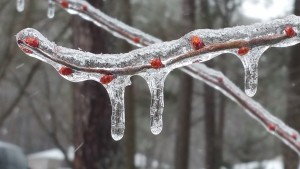
Image by Lucy Bradley CC-0
- Select salt-tolerant species
- Avoid tree species with brittle wood, weakly attached limbs, or spreading, codominant branches/trunks, and weeping or vase-like crowns that are more susceptible to storm damage.
- Trees with upright, narrow crowns or fewer and thicker branches are less susceptible to storm damage.
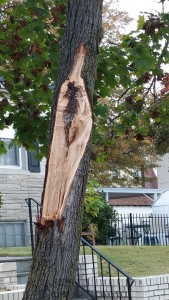
Image by Lucy Bradley CC-0
Identify Trees at Risk and Monitor Regularly
- Form: Trees with Co-dominant leaders, Bark that includes crotch, cavities or hollow areas are more likely to be damaged in storms.
- Evaluate leaning trees.
- Roots: Girdling roots can impede the root system and create a weak spot that is often the point of failure in storms.
- Decay: Damage from insects or disease can weaken the wood and make it vulnerable to storm damage.
- Damage: Injury from improper pruning (flush cuts, topping) and staking (with wrong materials or left on too long), mechanical damage from lawnmowers and weed-eaters, poor maintenance including mulch around the trunk, improper placement or amount of irrigation or damage to the roots through trenching..
- Site: Confined space for roots; shallow, compacted, or waterlogged soil; wrong plant for the space.
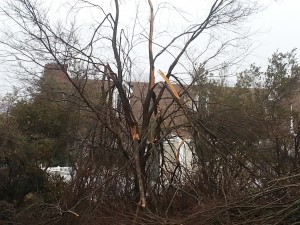
Image by Lucy Bradley CC-0
Preventative Pruning or Removal – Consider hiring a certified arborist.
- Remove dead, dying, diseased, or damaged limbs.
- Remove branches within 30 feet of houses or structures.
- Some problems can be eliminated with proper pruning.
- Other problems can not be corrected, remove the tree to prevent storm damage.
Management
First assess site safety. Check for downed power lines. Examine tree canopies for large broken limbs that could fall. Identify broken, bent and twisted limbs under tension that may unexpectedly spring back.
Remove the Weight
- After heavy snow, remove the snow from limbs with a broom, brushing up from below the limb and away from the tree. Start at the bottom and work up so as not to add to the load on lower limbs.
- Wait for the ice to melt.
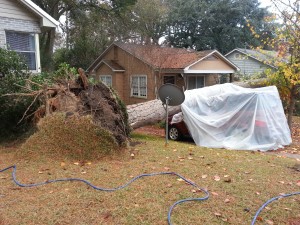
Image by Lucy Bradley CC-0
Assess the damage and decide whether to remove or keep the tree
- Remove:
- Trees that have other issues: poor health, unattractive form, messy, wrong place, undesirable species, insect or disease damage.
- Large, wind-thrown trees, ripped from the ground.
- Large, leaning trees.
- Trees with extensive trunk damage
- Trees with more than 50% of canopy damaged
- Trees with major limbs broken
- Trees where the central leader is broken
- Trees that will no longer be a beautiful asset to your landscape
- Consider keeping
- Small trees that have been uprooted. Immediately straighten, replant and stake.
- Small trees with an intact leader and scaffold branches.
- When in doubt, postpone the decision and evaluate the tree again in a few months.
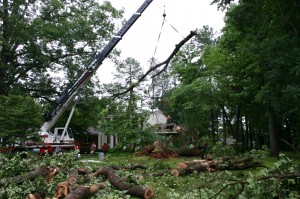
Image by Lucy Bradley CC-0
When to hire a certified arborist.
- If a ladder or chainsaw will be required to prune.
- If a crane or other large equipment will be needed.
- If there are power lines in the area.
- If there is potential for property damage.
- If there are bent or twisted branches under pressure that may cause kickback.
- If you want advice on whether to prune or remove the tree.
- The tree is of great sentimental or financial value.
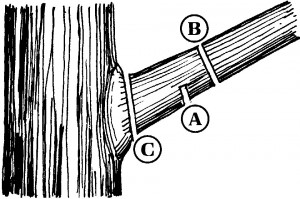
Image by the Arbor Day Foundation CC-BY-0
Corrective Pruning – consider hiring a certified arborist.
- Before the Cut
- Use the Right Tool
- Use a three-step process to remove the split, cracked, torn, or extensively damaged branches at their point of origin. See General Pruning Techniques for information on where and how to make pruning cuts.
- A. Several inches out on the limb, away from the trunk, make a partial cut, 1/4 of the way through the branch from the bottom of the limb. This will prevent the bark from tearing.
- B. Several inches beyond the first cut make a second cut beginning on the top of the branch and cutting all the way through the limb. This removes the weight of the limb.
- C. Make the final cut from the branch bark ridge to just outside the branch collar. This will allow the tree to seal the wound quickly.
- Remove jagged, rough edges.
- Clean up wounds – remove torn bark at the point of attachment.
- Do not top trees. Cutting back to a stub promotes the growth of weakly attached branches which are likely to be damaged in future storms.
- Many deciduous and evergreen shrubs (excluding conifers like thuja, juniper, cedars, and arborvitae) can be cut back to within a few feet of the ground and will regrow. However, they are unlikely to bloom the first year after pruning.
- Do not prune other than to remove damaged wood. The tree will need all its remaining leaves to produce food for regrowth. Wait until the tree recovers to do cosmetic pruning.
- Do not paint the wounds.
Straighten and stake small uprooted trees.
Cabling and Bracing
- This is usually a preventative strategy rather than a corrective one.
- Consult a certified arborist
Do not fertilize storm-damaged trees
Select, stronger, better-adapted species when replacing trees.
__________
More information:
- Handling Storm Damage in the Landscape
- Storm-Damaged Residential Trees: Assessment, Care and Prevention
- Storm Recovery – The National Arbor Day Foundation Print Version
- What to do after a hurricane (University of Florida)
- Dealing with Storm-damaged Trees In the Landscape (Louisiana State University)


